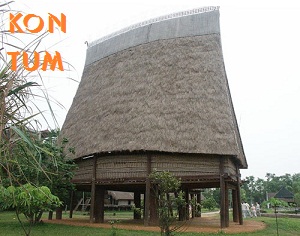- Vietnam Overview
- Main Cities in Vietnam
- Regions in Vietnam
- Other Cities in Vietnam
- Getting to Vietnam
- Getting Around Vietnam
- Language in Vietnam
- Education in Vietnam
- Vietnam Activities
- Vietnam Attractions
- Vietnam Money & Shopping
- Eating and Drinking in Vietnam
- Dress Code in Vietnam
- Gift Giving in Vietnam
- Public Behavior in Vietnam
- Art Performance
- Custom and Habits
Kon Tum Province
Visitors would observe beautiful wooden stilt houses in Ba Na villages and Communal House (Nha Rong) that only be found in villages on the north of the Central Highlands.
Geography
Kon Tum is on Central Highlands. It shares border with Laos, Cambodia on the west, Quang Nam Province on the north, Quang Ngai Province on the east and Gia Lai Province on the south.
On the north, there is highest granite mountain region in Southern Vietnam with Ngok Linh 2,598m and Ngoc Phan 2,251m. It is source of Tranh, Thu Bon, Tra Khuc, Ba rivers.
Forest covers 50% total of Kon Tum area with valuable wood, rare birds. Basalt soil is suitable to plan rubber, coffee, tea, sugar cane. The province has 26,000ha grassland that gives good condition to raise cattle.

Kon Tum is divided into 8 districts:
- Đắk Glei
- Đắk Hà
- Đắk Tô
- Kon Plông
- Kon Rẫy
- Ngọc Hồi
- Sa Thầy
- Tu Mơ Rông
The capital, Kon Tum, is its own municipality.
There are 76 communes, 10 wards, and 6 towns.
Climate: Kon Tum has feature climate of Central Highland. That is tropical monsoon one. There are two seasons. The rain season lasts from May to October. The dry season lasts from November to April next year.
Annual average temperature is 23.4ºC. Annual average rainfall is 1,884mm.
Tourism
Coming to Kon Tum, visitors enjoy mountainous landscapes like Ngok Linh Mountain, Chu Mon Ray Primitive Forest, Dak Tre Tourist Site, and Dak To Hot Spring. Tourists are interesting in historical relics such as Kon Tum Former Prison, Dak Glei Prison, Ho Chi Minh Trail, Dak To, Tan Canh Battle Field.
Visitors would observe beautiful wooden stilt houses in Ba Na villages and Communal House (Nha Rong) that only be found in villages on the north of the Central Highlands.

